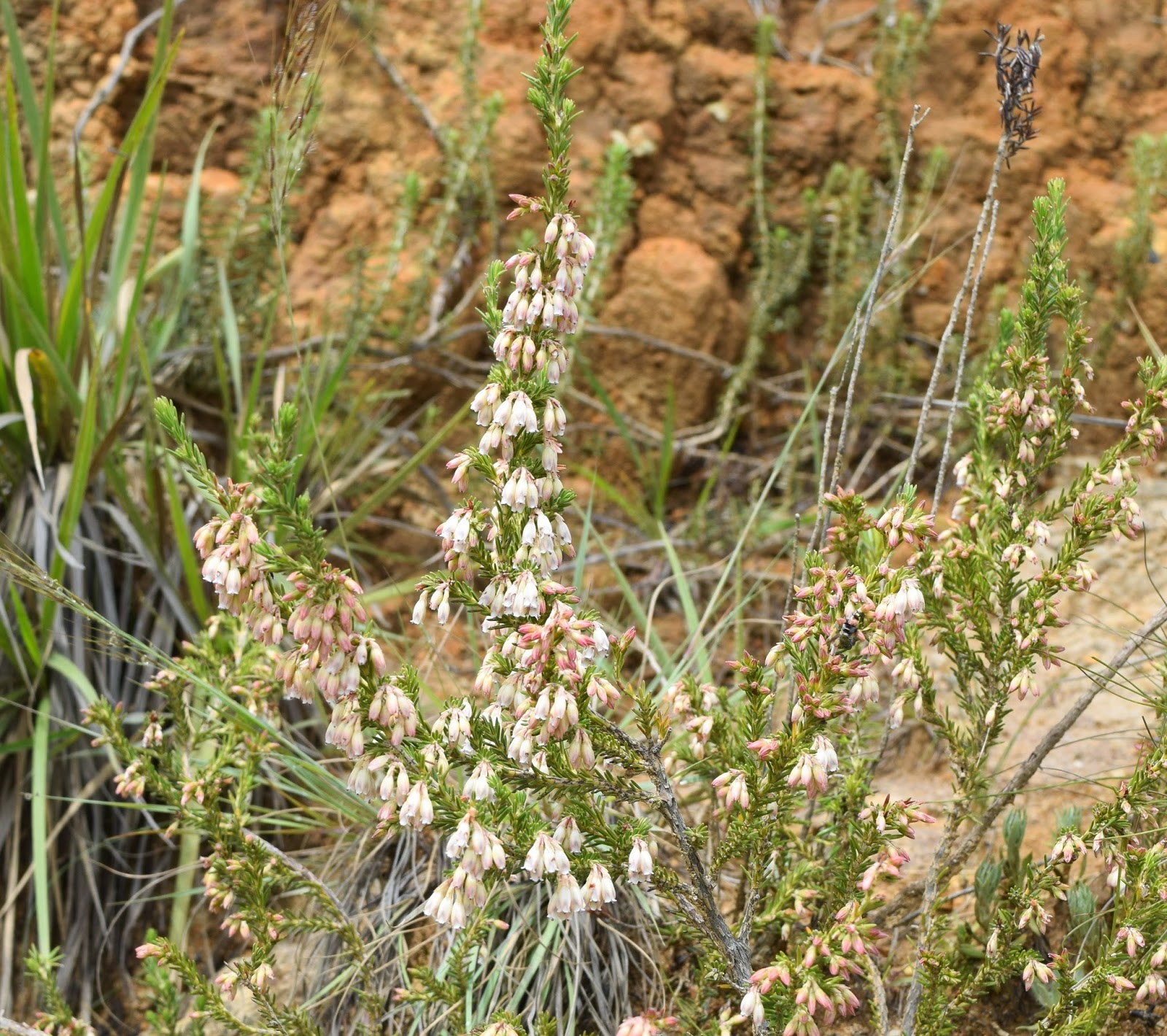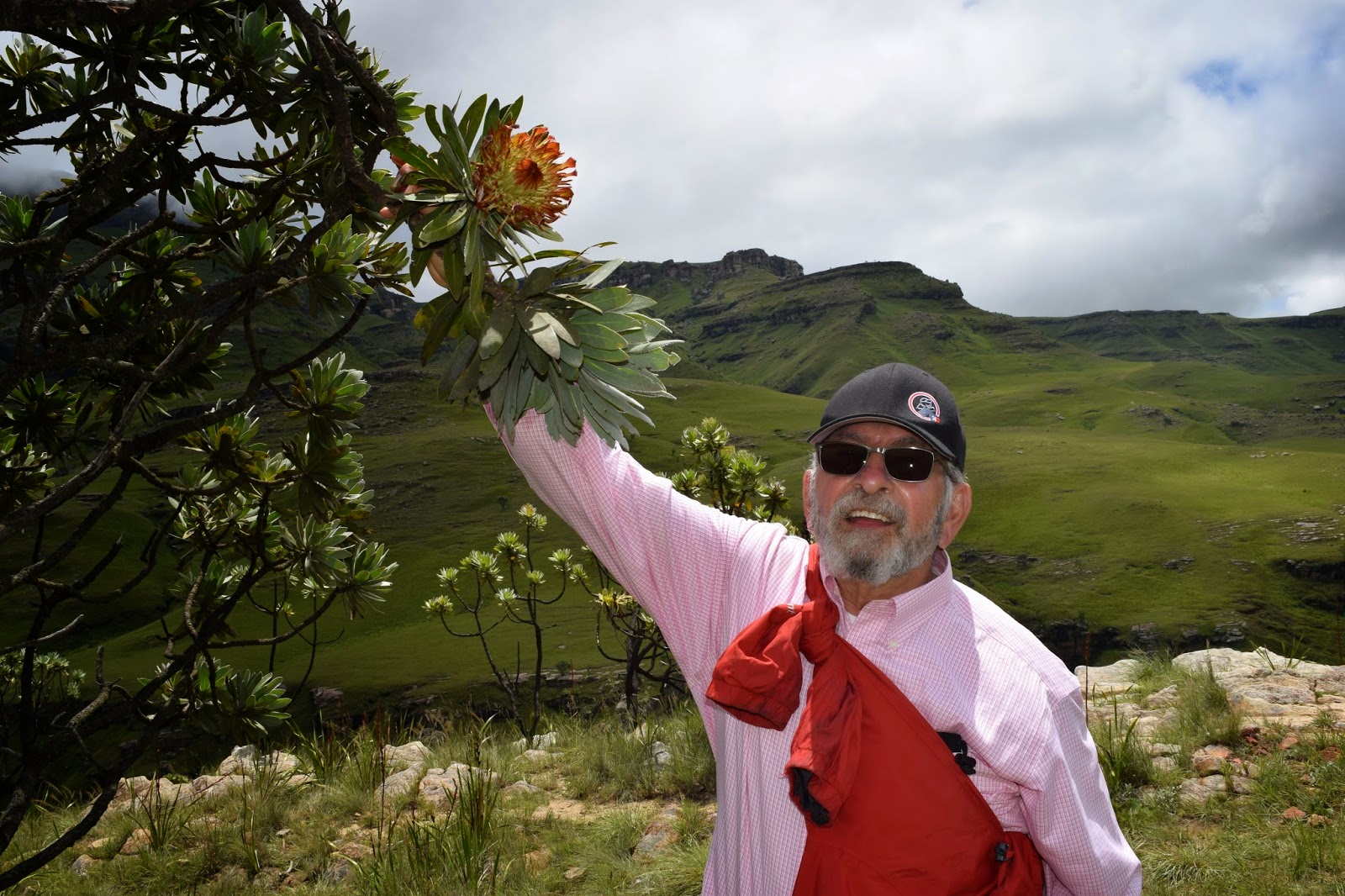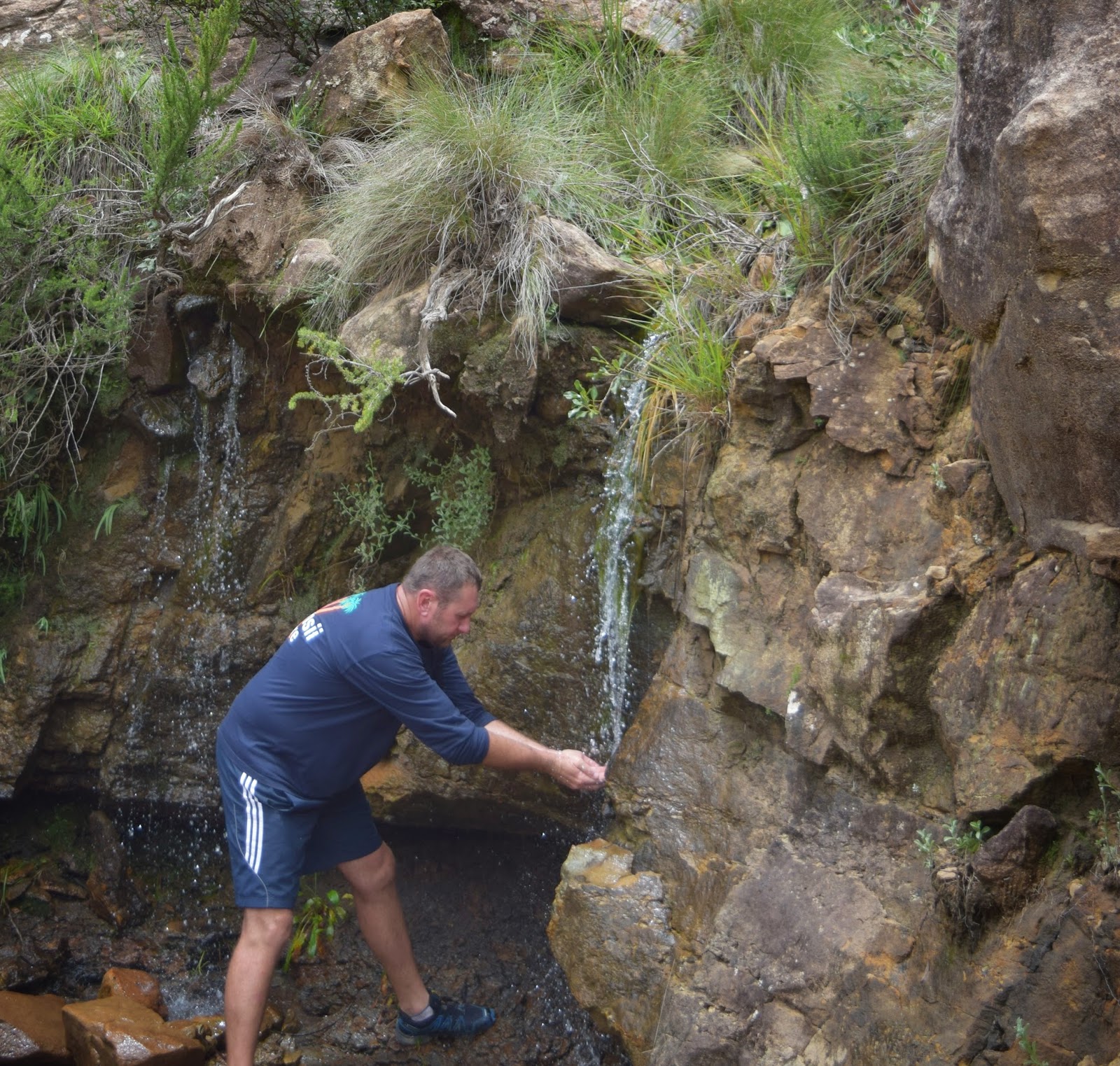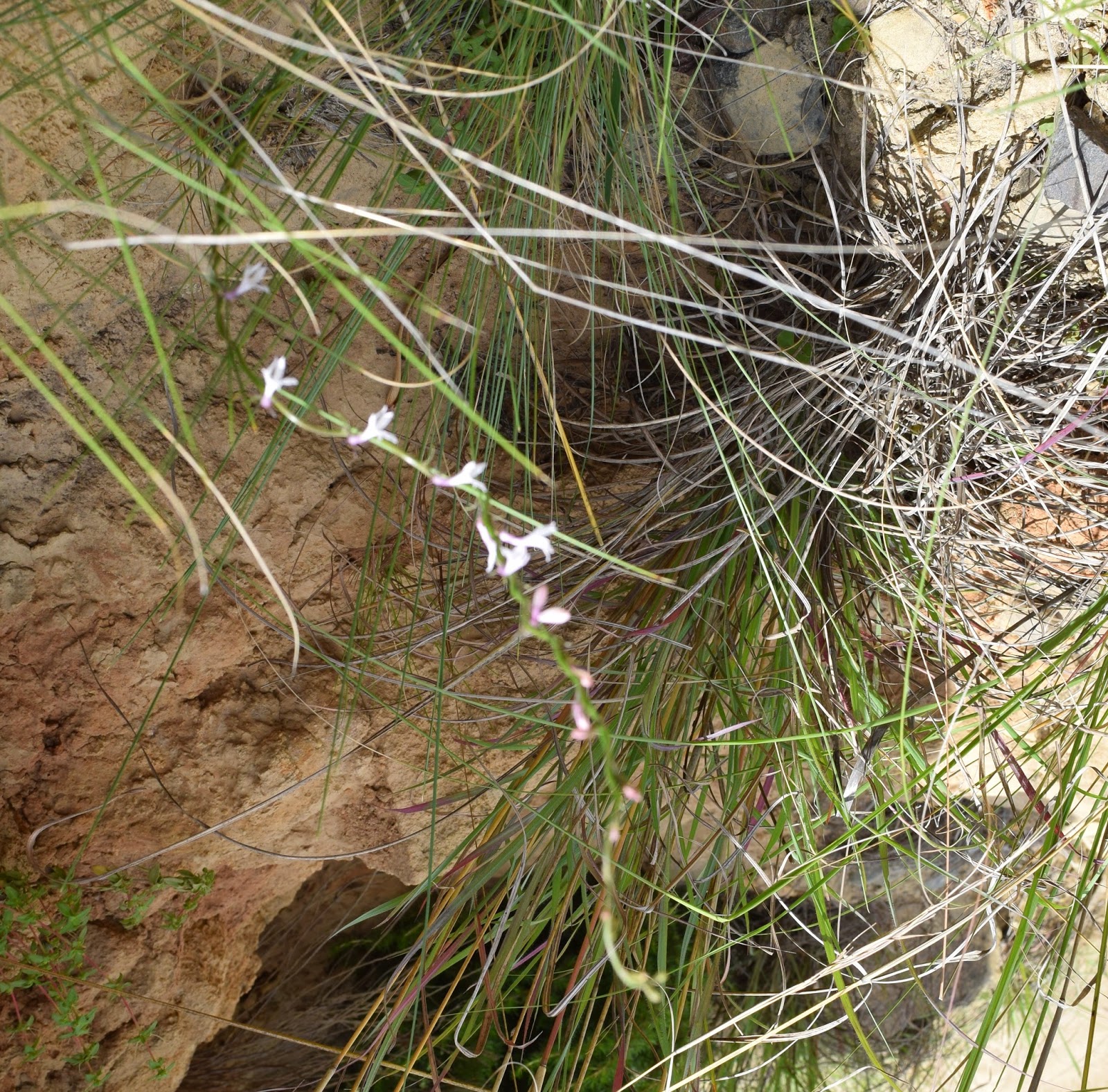 |
| Cyperus obtusiflorus v. flavissimus |
This may be my all time favorite sedge: quite common all over the foothills of the Drakensberg (the "Little Berg" it was one of the highlights of a thwarted attempt to get up Sani Pass (sigh). We did nevertheless see some good stuff before heading down to Howick (the last part of this Blog)...Be warned: Sani Pass is closed this season, and the road requires four wheel drive. Compare this sedge with the much bronzier one I photographed
at Drakensberg Gardens and posted a few weeks ago: wait till you see the monster we found at Platberg (to be posted in a week or so)...
 |
| Erica cerinthoides |
I've seen this before (there were miles of it at Drakensberg Gardens) but here it was still blooming. This heather is widespread in South Africa: it can be a brilliant scarlet and make a shrub several feet tall. This higher altitude form, however, could be cold hardy in much of the USA..
 |
| Hypoxis sp. (close to hemerocallidea) |
Hard to believe we share this genus--albeit the South African ones are wildly variable!
 |
| Rhus sp. |
Sumac grow everywhere it seems: this species is uncannily similar to our North American
R. aromatica or
R. trilobata..although our's have more orangy-red berries. These have a similar lemonade taste.
 |
| A locust |
The South African locusts are amazing.
 |
| Erica caffrorum |
Compare with trhe husky plant
at Drakensberg Gardens, I posted a few weeks ago...
 |
| Bracken |
I have not looked up to see if the South African bracken is a different species from our's: sure looks the same! I know it's regarded as a horrible weed in many climates, but I have a warm spot in my heart for this rangy fern: it grows thickly on Rabbit Ear's Pass in Routt county (near where I was born) and there are thick colonies on Flagstaff mountain near where I grew up. And it's found near both my parents' villages in Greece--I guess you could say it grows everywhere so it's not accident it's near so many places I love, not least of which is South Africa!
 |
| Themeda triandra |
A meadow full of Themeda: we'll be seeing some lovely specimens up close soon of this outstanding grasss.
 |
| Protea roupelliae in the foreground |
I know this protea is found far beyond the Drakensberg, but it is so emblematic of the "Little Berg" I always associate it with these foothills. It was heartbreakingly lovely up against the green green hills dotted with giant tree ferns. These mountains are hard to beat!
 |
| Al Gerace |
It was signal honor to have Al Gerace and his wonderful wife Enza on this trip. Al is not just a kingpin--he's the very heart of our regional green industry: the two of them were a daily delight to be around: love seeing him shake hands with the Protea here!
 |
| Protea roupelliae (again!) |
 |
| Protea roupelliae (and yet again!) |
You can't really blame me for dwelling on this a bit, can you?
 |
| Cliffortia sp. |
I haven't had time to figure out which one, but this is South Africa's rather too modest representative of the Rosaceae. When you see the flowers in the next frame you'll see what I mean. They characterize Fynbos, which is why many consider the Drakensberg to be an "Afromontane" cousin to the West Cape's Fynbos (many shared genera like
Protea, Erica, Passerina, Watsonia etc.) The sort of thing only biogeographers could salivate over....
I think it's a rather statuesque thing, with a habit rather like a conifer...
I can see you yawning from here, so I'll move on...
 |
| Senecio oxyriifoliusie!) (thanks for the I.D., Ernie!) |
|
|
|
|
|
|
| | | |
|
 |
| Commelina africana |
Although this yellow dayflower is found throughout South Africa, it doesn't seem to me as though it would be weedy: I would love to try it in the garden...
 |
| I think the flowers are very cute! |
Whenever I see a
Commelina, especially in South Africa, I think of Bob Faden, retired botanist at the Smithsonian, who was the authority on these: he and his wife are enthusiastic and accomplished gardeners as well!
 |
| Helichrysum vernum |
It was a tad galling to see the luscious rosettes of this strawflower everywhere--looking for all the world like an Echeveria or Dudleya...and not a single flower or seedhead. It must either not have bloomed this year, or bloomed so early the stalks have disintegrated. The flowers on this are usually huge and bright rose red. If you
click here you will see what it looks like in flower (in a blog I wish I had never had to write).
 |
| Themeda triandra |
The first of my two shots: not terribly impressive. If you click on it it will become a little more impressive (and you can gloss through this blog without my droning on about things)...My dirty little secret.
 |
| Had to show two more P. rouppeliae... |
Did I mention I love the Proteas? But who doesn't?
 |
| Karel De Toit |
The water in the Drakensberg (knock on wood) is so pure and clean you can drink it. Really!
 |
| Now THIS is a Themeda |
There are no end of wonderful grasses, and South Africa has more than her share. I would love to grow this wonderful blue leaved
T. triandra!
 |
| Berkheya sp. |
We saw no end of this sort of
Berkheya all across the highveld, almost to Kruger (which is lowveld I know)...
A miserable picture of
Cyphia, a vining Campanulad. Haven't quite figured out the focus on my dang camera!
 |
| Cussonia paniculata |
I know the Cabbage Trees are everywhere in South Africa--especially in the High and Lowveld. But I never tire of them. Love this outside bonsai clinging to the cliff--with the green hills beyond. I am horribly homesick for this landscape already.
 |
| A wonderful mystery grass along the road (very pink) |
 |
| Merxmuellera sp. |
|
The other widespread clumping grass of the Little berg--these are such amazing meadows! I'll inflict this picture on you again below, this time featuring the puffy clouds...
How, prithee, am I supposed to pick between these two? They both epitomize the landscape there I've come to love--the wonderful "platberg" (table) mountains, the green green hills, the blowing grasses and the puffy clouds. Really, the Drakensberg are Heavenly.
 |
| Oxalis obliquifolia |
Closely allied to the
O. depressa often sold in America--this is ubuiquitous in this area (and everywhere else in the Drakensberg). I love it!
 |
| Hypoxis sp. |
Here's one of the larger hypoxis--the genus is amazing here.
 |
| Oenothera sp. |
There are a few weeds in Paradise: I saw several species of Evening Primrose, presumably from South America. This and the one below were growing together--very strange!
 |
| Oenothera sp. |
 |
| Karel photographing a Rubus |
Haven't yet figured out if this is one of the several invaders, or one of the few native species. Location suggests a weed.
 |
| Rubus sp. |
The fruit was not quite ripe: guess how I know?
 |
| Hypericum sp. |
We saw one big patch of St. Johnswort: very pretty...I haven't looked it up but I have me doots. It may be exotic.
 |
| Zantedeschia aethiopica |
Fast forward forty or more miles--we're on the road to Howick (justr before the fog turned into pea soup consistency). I have been surprised this trip how much of the typical Calla Lilies occur everywhere in the Drakensberg, rather than their spotted (
Z. albimaculata) summer rainfall species. There have to be some hardy clones of this...Large forests of
Pinus patula cover the slopes in this area.
 |
| Agrimonia procera |
Just noticed the Agrimony is growing with a Geranium I didn't photograph (I tried to document these for Robin Parer and Ernie Demarie--my two good Geraniaceae fan club buddies). This Agrimony looks exactly like
A. eupatoria from Eurasia and several North American species--another of the links between our regions.
 |
| The pine woods are not so attractive when they're cut... |
I know South Africa needs wood--and forests grow lustily here. But there were never ever forests in these regions: instead, there were fabulously rich grasslands, largely replaced by farms and forest. I find that very sad.
 |
| Kniphofia parviflora |
We found several dozen showy plants in one tiny strip of grassland left in this area--including several orchids. Surrounded by the utterly impoverished pine plantations (impoverished in terms of biodiversity I hasten to add...) This is in the running for the ugliest poker...
 |
| Kniphofia parviflora |
And here's an even uglier one!
 |
| Ledebouria sp. |
I have seen some Drakensberg Ledebourias thriving in Sweden and Scotland, but I don't believe we have any of the higher altitude species yet in the U.S.A.: the flowers are generally not very showy, but the foliage is to die for. This is one of the best. Hate to think of how many of these were snuffed out by the pine woods.
 |
| Watsonia lepida |
And some fine specimens of the pink Watsonia of the Drakensberg...
 |
| A delicate Lobelia |
 |
| Closer view of the Lobelia above |
 |
| Asclepias cultriformis |
The Drakensberg boast no end of Asclepiads--in all colors and forms. It has to be a major center of the genus (and family). This is one of the loveliest...You can see much better pictures of this
at this blog.
 |
| One of the hundreds of orchids in the Drakensberg environs |
I forgot to key this out--will do so and come back and label it in a few days...
 |
| Kniphofia laxiflora |
I believe I have the species right--I show many more of these at a locality a few dozen kilometers away further down this blog. A fabulous plant...
 |
| Phytollaca octandra |
I was startled to see this pokeberry--which is pantropical and probably a weed here.
 |
| Phytolacca octandra |
It may be a weed, but it looks as trim as a shrub from Monrovia!
 |
| Gladiolus ecklonis |
This speckled green and black Glad is closely allied to
G. dalenii, and has a wide range. I've seen it growing just a few inches tall on the alpine turf of Sentinel in years past (but not this year!)
I was countermanded and we drive perhaps an extra unnecessary sixty miles through pea soup fog almost not be able to see the famous falls at Howick. End of conversatrion...
I was able to get a picture of this rather charming way sign..
 |
| Dais cotinifolia |
There are great recompenses in this life, however. We stayed at a really wonderful lodge that evening (eventually), and the next morning the fog had lifted and we saw a whole hillside covered with this wondeful cousin to Daphne. It was breathtaking!
Dais grows all over the Drakensberg, but had finished there--for whatever reason, they were lingering still in the Midlands (I think they'd had more cool weather) so we were able to see one of my all time favorite trees. I've only seen this in bloom on one other occasion, my first trip when I came early enough to catch the last flowers.
Imagine
Daphne cneorum on steroids--on stilts--growing thirty or even forty feet tall. WOW!
 |
| Kniphofia laxiflora |
On one hillside we stopped to commune with this elegant poker: the next few pictures speak for themselves...
 |
| Kniphofia laxiflora |
 |
| Kniphofia llaxiflora |
 |
| Kniphofia laxiflora |
And we returned to Howick falls the next morning--and fortunately the fog had lifted (mostly) so we could glimpse the falls and shop a few minutes (and get a decent cup of coffee! Our wonderful lodge the day before only had instant--I need to talk to them before I go back. Which I hope I shall)...
We have but one more day and two more hillsides, and I shall have completed the circuit of the Drakensberg for you. I have been blessed to visit mountains on five continents--but there is something about this range that is very near and dear to my heart. I hope you too are becoming smitten!



































































Hmm.. wonder if this will show up twice... Great stuff- especially interesting to see some of the high altitude/potentially hardy stuff, like the Ledebouria!
ReplyDeleteThe Ledebourias were a big "take Home" (the knowledge, not the plants, alas!). I know there are a few hardy ones kicking around Europe. We must start with those...your post only showed up once! (Computers can be so aggravating: can't live without 'em, but sometimes you can't stand 'em).
ReplyDeleteNice photos again, like those different colors of the K laxiflora. The senecio is S. oxyriifolius, I grow it in a pot, it has tuberous roots. I also have the yellow sedge in a pot, it is very pretty and quite common in the grasslands, but the prettiest of all sedges is Ficinia radiata from the Western Cape, I have seen it in flower (and have some seed but have yet to get it to germinate) it has huge yellow petal like bracts on a small plant. Didn't know about the high altitude ledebouria you show, there are ledebourias of all kinds all over SA and also in Botswana near Gaborone, they are as confusing as the hypoxis species swarms are. One that is hardy here and can be found in some nurseries (but I will have to see after this winter because I got a couple thru last winter and planted out quite a few more, they clump really fast, and I kept a bit inside as insurance) is L cooperi. Its small but actually does have pretty flowers and striped leaves. If the numerous divisions from a large pot that I put out show up this spring than I will be able to confirm its hardiness, because we cant get much worse than these last two winters. Ernie
ReplyDeleteThanks for the I.D.'s, Ernie: I hope I shall get germination on the oxyriifolius as well! Good luck on germinating Ficinia. I think C. obtusiflorus, however, should prove hardy! It's incredibly variable, and every form is wonderful. I am surprised you've had cooperi make it--its definitely from warm temperate areas that rarely freeze--you really are zone 7. We'd need to seek the high mountain forms for any luck here. Thanks for the notes!
ReplyDelete